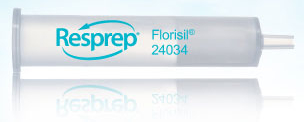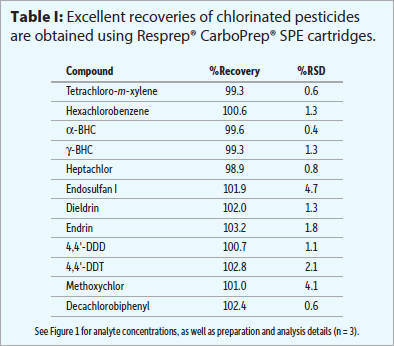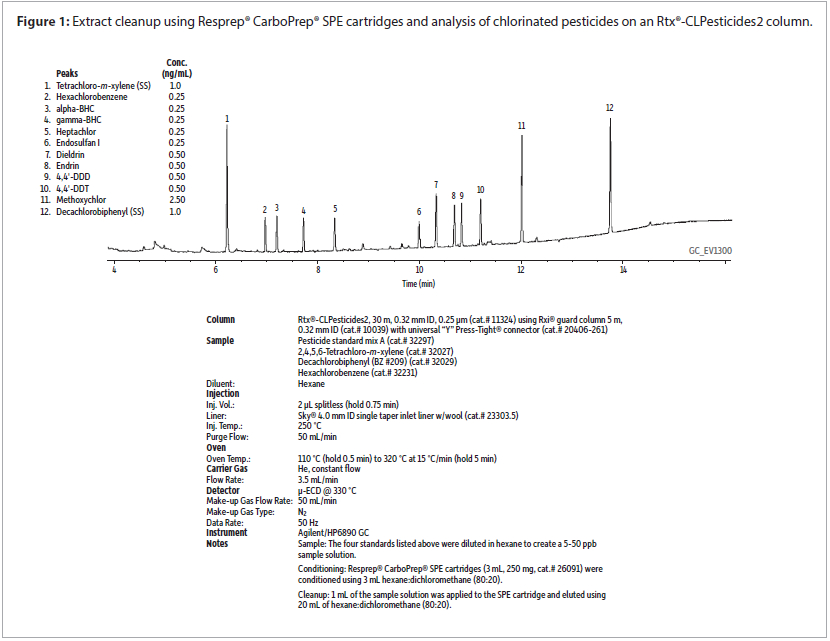01494 563377
Editorial
 Improve results for GC-ECD Analysis of Chlorinated Pesticides
Improve results for GC-ECD Analysis of Chlorinated Pesticides
with Resprep® CarboPrep® SPE Cleanup Cartridges
Many chlorinated pesticides have been banned for use because of their short-term and long-term toxiticity, carcinogenicity and environmental persistence. An expanded list of these chemicals, some of which are still actively applied in the field, has been included in the updated U.S Environmental Protection Agency (EPA) Method 8081B.
Despite the fact that most of these chlorinated pesticides are now illegal to use, manufacture and transport in the U.S., organochlorine compounds are still a potential source of pesticide poisining. Although most of these chlotinated pesticides have limited water solubility and mobility, they do bioaccumulate and persist in the environment. Since there is an ongoing risk for exposure from a number of sources, it is still essential to test soils, wastewater and sediments for their presence.
One of the primary challenges chemists gave with 8081B analysis is chromatographic interference from matrix compounds. This is because the methylene chlorise or acetone/methylene chloride solvent used for the extraction of water and soil also removes a wide variety of organic matrix compounds. To reduce interferences in the sample extracts, gel permeation chromatography (GPC) and/or solic phase cleanup is recommended. The GPC cleanup step removes high molecular weight organic compounds, which can create active sites in the injector if they do not volatilize completely. For solid phase cleanup, Florisil® absorbant is commonly used to clean extracts by removing polar contaminants.
 Even after GPC and Florisil® cleanup steps, matrix interferences typically still remain. SPE cleanp of chlorinated pesticide samples with Resprep® CarboPrep® SPE cartridges can further improve results by removing sterols, pigments, and nonpolar interferences, without comprimising the recovery of pesticides. Extracts will have lower backgrounds, which results in fewer chromatographic interferences, extrended lifetime for inlet lines and guard columns, and reduced maintenance of sensitive ECD detectors. Results in Table 1 show that recovery levels are excellent for this chloronated pesticides list, when following the cleanup procedure describes in Figure 1. While many of the components included in EPA Method 8081B are difficult to fully resolve using GC-ECD, target components can be reliably separated using the Rtx®-CLPesticides and Rtx®-CLPesticides2 column pair.
Even after GPC and Florisil® cleanup steps, matrix interferences typically still remain. SPE cleanp of chlorinated pesticide samples with Resprep® CarboPrep® SPE cartridges can further improve results by removing sterols, pigments, and nonpolar interferences, without comprimising the recovery of pesticides. Extracts will have lower backgrounds, which results in fewer chromatographic interferences, extrended lifetime for inlet lines and guard columns, and reduced maintenance of sensitive ECD detectors. Results in Table 1 show that recovery levels are excellent for this chloronated pesticides list, when following the cleanup procedure describes in Figure 1. While many of the components included in EPA Method 8081B are difficult to fully resolve using GC-ECD, target components can be reliably separated using the Rtx®-CLPesticides and Rtx®-CLPesticides2 column pair.
Adding ResPrep® CarboPrep® 90 cartridges for SPE cleanup of chlorinated pesticide samples is an effective way to minimise interferences and improve method accuracy. Labs interested in imporiving results for chlorinated pesticides analysis should consider adding CarboPrep® SPE cleanup to exisiting procedures and switching to Rtx®-CLPesticides and Rtx®-CLPesticides2 columns.



